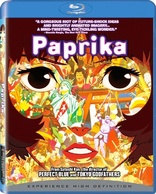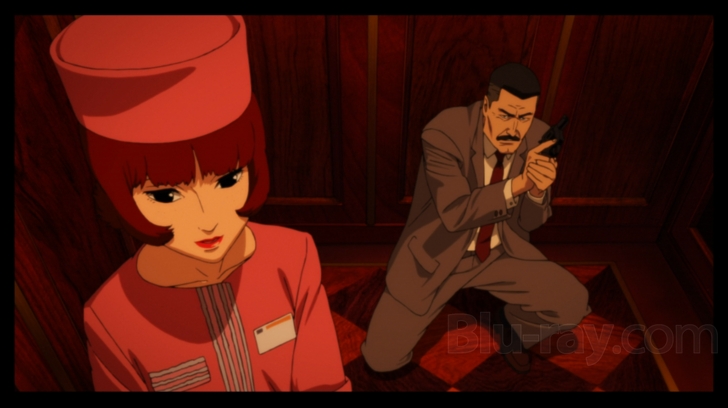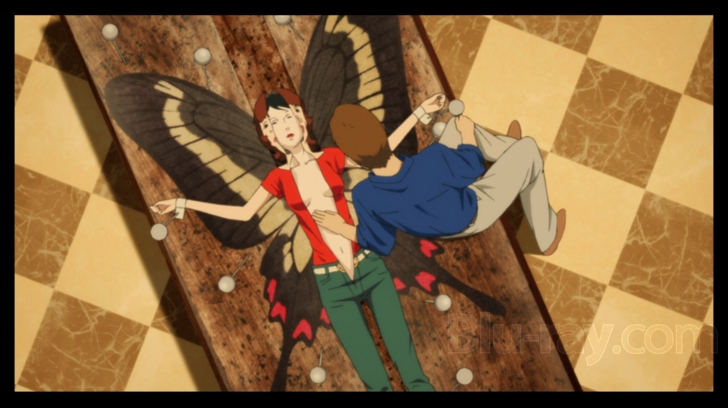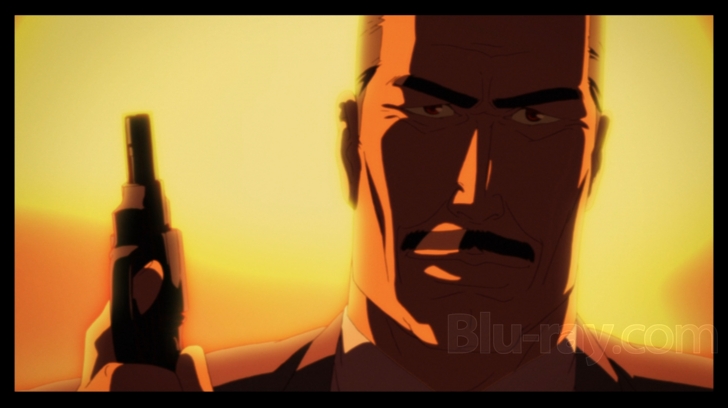Paprika Blu-ray Movie
HomePaprika Blu-ray Movie 
パプリカSony Pictures | 2006 | 91 min | Rated R | Nov 27, 2007

Movie rating
7.9 | / 10 |
Blu-ray rating
| Users | 4.4 | |
| Reviewer | 4.5 | |
| Overall | 4.5 |
Overview
Paprika (2006)
When a machine that allows therapists to enter into people's dreams and explore their unconscious thoughts is stolen, the research facility is sent into an uproar and all hell breaks loose. In the wrong hands, the device could be devastating, allowing the user to completely annihilate a dreamer's personality while they are asleep. Only a young female doctor named Atsuko Chiba can stop it. Entering the dream world under her exotic alter-ego, code named "Paprika," she attempts to discover who is behind the plot to undermine the new invention.
Starring: Megumi Hayashibara, Toru Emori, Katsunosuke Hori, Tôru Furuya, Akio ÔtsukaDirector: Satoshi Kon
| Foreign | 100% |
| Anime | 71% |
| Surreal | 17% |
| Imaginary | 10% |
| Mystery | 7% |
| Sci-Fi | 7% |
| Thriller | Insignificant |
Specifications
Video
Video codec: MPEG-2
Video resolution: 1080p
Aspect ratio: 1.86:1
Original aspect ratio: 1.85:1
Audio
Japanese: Dolby TrueHD 5.1
English: Dolby TrueHD 5.1 (48kHz, 16-bit)
French: Dolby Digital 5.1 (448 kbps)
Spanish: Dolby Digital 5.1 (448 kbps)
Portuguese: Dolby Digital 5.1
Mandarin: Dolby Digital 5.1
Cantonese: Dolby Digital 5.1
Thai: Dolby Digital 5.1
Japanese: Dolby TrueHD 5.1 (48kHz, 16-bit)
Subtitles
English, English SDH, French, Portuguese, Spanish, Korean, Mandarin (Traditional), Thai
Discs
50GB Blu-ray Disc
Single disc (1 BD)
Playback
Region free
Review
Rating summary
| Movie | 5.0 | |
| Video | 4.5 | |
| Audio | 4.5 | |
| Extras | 4.0 | |
| Overall | 4.5 |
Paprika Blu-ray Movie Review
Looking stellar in high definition, this visually astounding animé is not your average cartoon pap.
Reviewed by Lindsay Mayer April 11, 2008As a big fan of animation, there are films like Paprika that are at once entertaining, and a bit depressing. The former is obvious - the film not only utilizes a hand-drawn medium to the fullest in order to create some real eye candy, but it even has - gasp! - a substantial, sometimes challenging story to go along with it. It really is a marvelous piece of work. How then would it cause me melancholy? Well, because it's an animé, produced in Japan by the crazy workhorse director Satoshi Kon. It shows the vast potential of the animation medium in all of its forms; it is not simply just "kiddie fare." The Japanese have embraced this potential - some of it due to practical motives, really. Animation is cheaper to produce than live-action films on the island nation, thus the amount of drawn output is staggering, especially in comparison to the collective works of countries within America and Europa.

Paprika acts as a dream guide for the troubled Detective Kogawa Toshimi.
Quantity does not dictate poor quality, however. Many feature films from Japan are incredibly well-orchestrated productions, with solid storytelling almost always at the core, no matter the genre. Paprika is certainly no exception. Playfully metaphysical, the plot involves the desperate search for a missing experimental device called the DC Mini, which can literally record a person's dreams and play them back for analysis. The powerful new invention not only passively documents dreams, however; it allows one to access the subconscious. Needless to say, in the wrong hands, the DC Mini is a means to total psychological destruction - and control - of an indefinite amount of individuals.
In Paprika, the human subconscious and the "dream world" are seen as a vast interconnected matrix, through which deliberate disruption spreads like a cancer. The only people capable of tracking down the three stolen Mini prototypes and reversing their disastrous effects are its original researchers; chief doctor Shima Tora-taroh, oversized and childlike genius developer Tokita Kohsaku, researcher Osanai Morio, and the film's protagonist, Atsuko Chiba. To be fair, it isn't actually Atsuko who does most of the detective work, but her dream world alter ego, code name Paprika. The spunky, warm, youthful Paprika is everything the cool, reserved Atsuko is not, and it is her responsibility to delve into the unpredictable realms of the human mind in order to seek the whereabouts of the Minis, and prevent the merged "superdream" of Mini victims from spilling over into the waking world.
What ensues is some astounding visual imagery accompanied by an intriguing sci-fi mystery. Nothing offers more potential for truly bizarre surrealism than our own dreams, and animation is the perfect medium to capture it as such. I was actually quite surprised at how engrossed I became into this film, as the eye candy, the story, and the accompanying score mesh together harmoniously to create a wonderful result. I really agree with Paprika's tagline. This is your brain... on animé.
Paprika Blu-ray Movie, Video Quality 

The look of Paprika is purposely softened and ethereal, but the transfer perfectly captures the film's wonderful color palette - from the cooler indoor and laboratory color tones to the vibrant palette of the more surreal dream sequences. Using an MPEG-2 encode, the bitrate averages around 25 Mbps, and looks fantastic. Black levels and contrast are exceptional, shadow detail is impeccable and there isn't a hint if any compression artifacts to be found in this transfer. One area in animation that can really show up the compression artifacts is in solid dark colors such as an indigo background, etc. This release shows no mosquito effect, no posterization, and certainly no edge enhancement. In effect, Paprika should stand for a long while as one of the reference BD titles for hand-drawn animé.
Paprika Blu-ray Movie, Audio Quality 

This release boasts a rather impressive array of languages; two lossless Dolby TrueHD 5.1 tracks in Japanese and English, as well as Spanish, Portuguese, and French in Dolby Digital 5.1. Another appreciated feature is the inclusion of the literally translated English subtitles, as well as the adapted English, Spanish, Portuguese, French, Chinese, Korean, and Thai.
For review purposes, I watched the feature in Japanese with literal English subtitles, and thereafter sampled a few chapters in the English dub. Though the dialogue is kept almost entirely to the center channel, it is an overall aggressive mix with a high level of ambience in the surround channels and many discrete special effects either panned to the rear or panned around the entire room. In fact, even the film's mostly-techno soundtrack has discrete instrumentation mixed into the surround channels, particularly during the film's main theme. Dialogue is natural and clear, conveying the full range of the human voice and never getting lost in the louder, more special effects-driven sequences. The LFE channel is used sparingly, but with great effect when it is employed; the soundtrack can hardly be described as "boomy," however. Though the mastering is generally relaxed, flat, warm and easy on the ears, there is just a slight boost in the high frequencies that is most apparent in the numerous "parade" dream sequences. This slight anomaly is hardly a deterrent from the overall enjoyment of the sound of this well recorded, mixed and mastered soundtrack.
Paprika Blu-ray Movie, Special Features and Extras 

Paprika comes with a rather standard package of supplements, mostly consisting of concise "behind the scenes" featurettes. Running between 10 and 30 minutes each, these making ofs have a distinct "promotional" feel to them, but are nonetheless interesting enough for a once-over viewing. All of the featurettes are presented in 4x3, standard definition 480p with Dolby stereo. Though every extra feature is in Japanese, a clear layout of subtitles is available, including the film's commentary.
Tsutsui & Kon's Paprika is an overview of the film's origins, focused around interviews with Paprika author Yasutaka Tsutsui and director Satoshi Kon. Tsutsui discusses how he wished to write an entertaining story which drew upon his knowledge of psychoanalysis, as well as imagery from his own well of dreams. Kon's work on the film is chronicled as well - from the adapted script, to singlehandedly drawing every storyboard, to recording his own cameo in the film alongside the author. In a parallel concept to Atsuko and Paprika, Kon mentions a concept he's termed "hoodlum emulation." That is, he will at times let the michievious, low-class "Hoodlum Kon" take creative control in order to run with certain whims and ideas he may have during the production process.
A Conversation About The Dream is a round table type of discussion amongst Tsutsui, Kon, and voice actors Megumi Hayashibara (Atsuko/Paprika) and Tôru Furuya (Tokita). The quartet mention favorite scenes from the film and relate some of their own dreams, and recurring themes within them. Hayashibara and Furuya share some of their apprehension during casting and recording for their characters, as well.
The Art of Fantasy features art director Nobutaka Ike discussing the various techniques used to convey a dream-like quality within key sequences of Paprika - most notably the use of color palettes between the dream world and "reality." The latter, as mentioned before, often utilizes muted, subdued tones - especially within the sterile ambience of the research lab. Dreams, by contrast, have incredibly vivid hues to enhance their surreal quality. When the realms of dreams and the waking world begin to chaotically mesh, so too do the colors get less distinct.
The Dream CG World interviews director of photography Michiya Kato, who reveals the subtle effects of CGI within the hand-drawn world of Paprika. Some sequences are more overt, such as the melting carpeted hallway within Detective Toshimi's recurrent dream. More often, CG effects were used to enhance the overall shots, such as parade confetti, costume sparkles, or the ripples and reflection of a street puddle. This attention to detail truly shows dedication and high production values on the part of the film crew.
Other tidbits include Storyboard Comparisons in which you can view three sequences in their storyboard stage, original drawing phase, and finished character paintings alongside the final look. The Feature Commentary includes director Satoshi Kon, composer Susumu Hirasawa, and associate producer Morishima, and is surprisingly the only place on the disc that you can get any insight on the film's music, as the score does not have a separate feature on its own. The obligatory Previews showcase other Sony titles available on Blu-ray, naturally.
Paprika Blu-ray Movie, Overall Score and Recommendation 

As much as it pains me that animation studios in the U.S. and beyond do not nearly push the potential of animation enough, in order to stay within the safe and profitable realms of "kiddie fare," there is at least a bit of consolation from international establishments. Europe has shown potential in the past, but unfortunately their productions are little known and hard to obtain for those of us across various "ponds." By contrast, animé - especially high profile features from the likes of Studio Ghibli and Satoshi Kon - is regularly ported across the Pacific, some even enjoying limited theatrical runs. I can't say I'm a bit jealous of the brilliant animated works that the Land of the Rising Sun has put out, but that surely does not dampen my enjoyment of them nonetheless.
Paprika is certainly a well-produced film altogether, much more a brilliant animated film. The wonderfully surreal imagery, the surprisingly substantial story, and the catchy, oddly appropriate techno soundtrack cohesively lead to a great film experience. I highly recommend this Blu-ray title for all animation fans and film aficionados!
Similar titles
Similar titles you might also like

Perfect Blue
パーフェクトブルー / Pāfekuto Burū
1997

Serial Experiments Lain: The Complete Collection
Anime Classics
1998

Redline
レドライン
2009

Eden of the East: Paradise Lost
Combo Pack
2010

Tekkonkinkreet
2006

Vexille 2077
Bekushiru 2077 Nihon Sakoku | Special Edition
2007

Ghost in the Shell 4K
攻殻機動隊 / Kôkaku Kidôtai
1995

Ghost in the Shell 2: Innocence
イノセンス / Inosensu
2004

Patlabor 2 The Movie
機動警察パトレイバー 2 the Movie
1993

Ergo Proxy: The Complete Series
Classics / エルゴプラクシー
2006

Ghost in the Shell: Stand Alone Complex
2002-2003

Eden of the East Movie: Air Communication
2009

Psycho-Pass: The Movie
劇場版 サイコパス
2015

A.D. Police Files
1990

Freedom OVA
2006-2008

Memories
Memorîzu
1995

Evangelion: 1.11 You Are (Not) Alone
Evangerion shin gekijôban: Jo
2007

Jin-Roh: The Wolf Brigade
人狼
1999

Paranoia Agent
妄想代理人
2004

Ghost in the Shell: Stand Alone Complex: Solid State Society
2006
